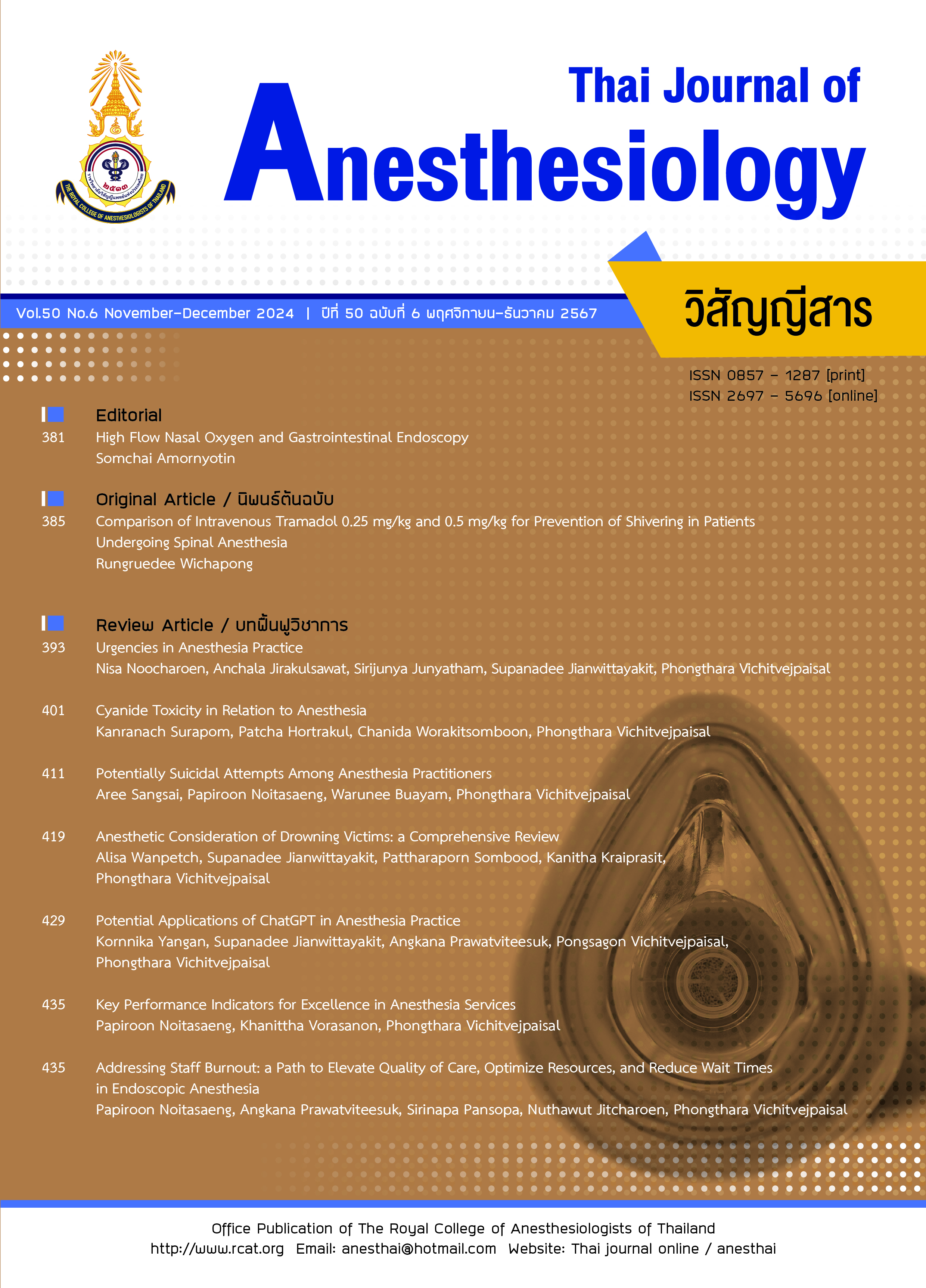Addressing Staff Burnout: a Path to Elevate Quality of Care, Optimize Resources, and Reduce Wait Times in Endoscopic Anesthesia
Main Article Content
บทคัดย่อ
This article delves into the pressing challenges facing endoscopic anesthesia units within healthcare facilities. Staff burnout emerges as a central concern, driven by high demands, long working hours, and the emotional toll of patient care. The article examines the profound impact of staff burnout on healthcare delivery, emphasizing compromised quality of care, increased medical errors, and reduced patient safety. It explores the intricate relationship between staff burnout, quality of care, resource allocation, and patient wait times, highlighting their interconnectedness. Resource optimization strategies, such as capacity planning, technology integration, and collaborative partnerships, are explored to ensure efficient resource allocation. Strategies to reduce patient wait times, including patient prioritization and technology solutions, are detailed to improve access to care. The article showcases initiatives like mental health support, resilience training, and work-life balance programs. It also advocates for policy changes and collaboration with policymakers to shape the future of endoscopic anesthesia services.
Article Details

อนุญาตภายใต้เงื่อนไข Creative Commons Attribution-NonCommercial-NoDerivatives 4.0 International License.
เอกสารอ้างอิง
Bazerbachi F, White RM, Forbes N, et al. Endo-anesthesia: a primer. Gastroenterol Rep. 2022;10:goac069.
Early DS, Lightdale JR, Vargo JJ 2nd, et al. Guidelines for sedation and anesthesia in GI endoscopy. Gastrointest Endosc. 2018;87:327-37.
Gotoda T, Akamatsu T, Abe S, et al. Guidelines for sedation in gastroenterological endoscopy (second edition). Dig Endosc. 2021;33:21-53.
Maslach C, Leiter MP. Understanding the burnout experience: recent research and its implications for psychiatry. World Psychiatry. 2016;5:103-11.
Taranu SM, Ilie AC, Turcu AM, et al. Factors associated with burnout in healthcare professionals. Int J Environ Res Public Health. 2022;19:14701.
O’Connor K, Muller Neff D, Pitman S. Burnout in mental health professionals: a systematic review and meta-analysis of prevalence and determinants. Eur Psychiatry. 2018;53:74-99.
Ulfa M, Azuma M, Steiner A. Burnout status of healthcare workers in the world during the peak period of the COVID-19 pandemic. Front Psychol. 2022;13:952783.
Romito BT, Okoro EN, Ringqvist JRB, Goff KL. Burnout and wellness: the anesthesiologist’s perspective. Am J Lifestyle Med. 2020;15:118-25.
Zahid MA, Nasir H, Zahid Z. The anesthesiologist, stress, burn-out and the coping strategies. Anaesth Pain Intensive Care. 2023;27:444−8.
Hall LH, Johnson J, Watt I, Tsipa A, O’Connor DB. Healthcare staff wellbeing, burnout, and patient safety: a systematic review. PLoS One. 2016;11:e0159015.
Salyers MP, Bonfils KA, Luther L, et al. The relationship between professional burnout and quality and safety in healthcare: a meta-analysis. J Gen Intern Med. 2017;32:475-82.
Eltaybani S, Yamamoto-Mitani N, Ninomiya A, Igarashi A. The association between nurses’ burnout and objective care quality indicators: a cross-sectional survey in long-term care wards. BMC Nurs. 2021;20:34.
Casalino LP, Li J, Peterson LE, et al. Relationship between physician burnout and the quality and cost of care for medicare beneficiaries is complex. Health Aff. 2022;41:549-56.
Tawfik DS, Scheid A, Profit J, et al. Evidence relating health care provider burnout and quality of care: a systematic review and meta-analysis. Ann Intern Med. 2019;171:555-67.
Leotsakos A, Zheng H, Croteau R, et al. Standardization in patient safety: the WHO High 5s project. Int J Qual Health Care. 2014;26:109-16.
Kwame A, Petrucka PM. A literature-based study of patient-centered care and communication in nurse-patient interactions: barriers, facilitators, and the way forward. BMC Nurs. 2021;20:158.
Roessler M, Schmitt J. Health system efficiency and democracy: a public choice perspective. PLoS One. 2021;16:e0256737.
Leeson PT, Thompson HA. Public choice and public health. Public Choice. 2023;195:5-41.
Dick-Sagoe C, Asare-Nuamah P, Dick-Sagoe AD. Public choice and decentralised healthcare service delivery in Lesotho: assessing improvement and efficiency in service delivery. Cogent Soc Sci. 2021;7:1969737.
Raghupathi V, Raghupathi W. The association between healthcare resource allocation and health status: an empirical insight with visual analytics. J Public Health. 2023;31:1035–57.
Haleem A, Javaid M, Singh RP, Suman R. Telemedicine for healthcare: capabilities, features, barriers, and applications. Sens Int. 2021;2:100117.
Ahlin P, Almström P, Wänström C. Solutions for improved hospital-wide patient flows - a qualitative interview study of leading healthcare providers. BMC Health Serv Res. 2023;23:17.
Johannessen KA, Alexandersen N. Improving accessibility for outpatients in specialist clinics: reducing long waiting times and waiting lists with a simple analytic approach. BMC Health Serv Res. 2018;18:827.
Harper PR, Gamlin HM. Reduced outpatient waiting times with improved appointment scheduling: a simulation modelling approach. OR Spectrum. 2003;25:207-22.
Otto MCB, Hoefsmit N, van Ruysseveldt J, van Dam K. Exploring proactive behaviors of employees in the prevention of burnout. Int J Environ Res Public Health. 2019;16:3849.
Awa WL, Plaumann M, Walter U. Burnout prevention: a review of intervention programs. Patient Educ Couns. 2010;78:184–90.


